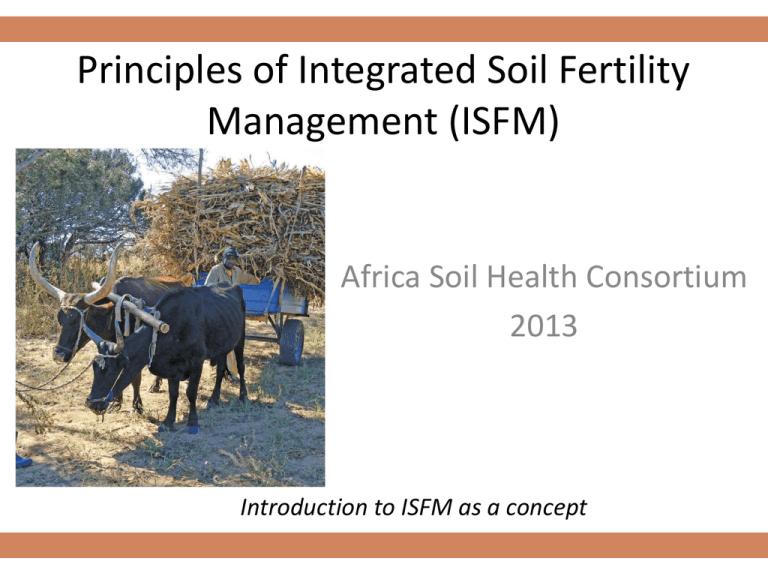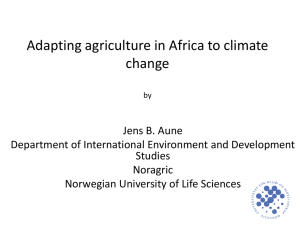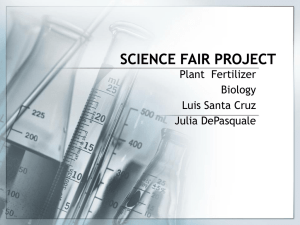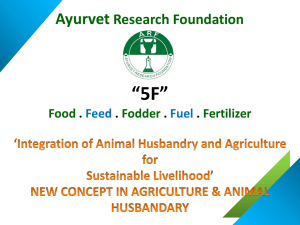( 3.9 MB) - Africa Soil Health Consortium (ASHC)
advertisement

Principles of Integrated Soil Fertility Management (ISFM) Africa Soil Health Consortium 2013 Introduction to ISFM as a concept Objectives • Understand the history of soil fertility management • Understand why ISFM is needed for smallholder farmers in sub-Saharan Africa • Understand the individual components of ISFM and their interactions with each other • Understand the variability between farms and the need for local adaptation of nutrient input recommendations • Understand the concept of agronomic efficiency • Understand the concept of economic efficiency History of soil fertility management Approach: external input use Approach: organic input use Approach: organic input use & fertilizer Approach: integrated soil fertility management Fertilizer: +++ Organic inputs: - Fertilizer: Organic inputs: +++ Fertilizer: + Organic inputs: +++ Fertilizer: ++ Organic inputs: ++ Limited success, shortfalls in infrastructure and farming systems Limited adoption, organic matter production requires land, labour and/or livestock Localized adoption around specific crops Goal of large scale adoption 1960s and 1970s 1980s 1990s 2000s Focus on mineral fertilizer Adding nutrients: The ‘Green Revolution’ • A success in Asia and Latin America – External input use (mineral fertilizers & lime) – Improved varieties – Irrigation • A disappointment in sub-Saharan Africa – Fertilizer is ‘too costly’ – Fertilizer use is uneconomic in poorly responsive environments – Fertilizer recommendations were not tailored to farmer’s specific circumstances • Heterogeneous soil fertility • The farmer’s social and economic situation and goals Focus on organic resources • Conserving nutrients: through compost and manure • Recycling nutrients : through deep rooting trees • Adding nitrogen: through biological N2 fixation (BNF) by leguminous cover crops, trees, shrubs and grain legumes Disadvantages: • Quality of organic resources is often poor • Quantity of manure or organic resources is not sufficient – Competing uses for plant residues • Organic materials are bulky and costly to store, transport and apply • Adoption and suitability of leguminous cover crops is limited by (1) high labour requirements (2) only N can be supplied (3) availability of other nutrients (e.g. P) need to be sufficient for effective BNF (4) drought and low soil pH limit BNF (5) lack of useable yield (grain legumes excepted) When unsufficient nutrients are added to maintain soil fertility: downward spiral into a poverty trap Integrated Soil Fertility Management ‘A set of soil fertility management practices that necessarily include the use of fertilizer, organic inputs and improved germplasm combined with the knowledge on how to adapt these practices to local conditions, aiming at optimizing agronomic use efficiency of the applied nutrients and improving crop productivity. All inputs need to be managed following sound agronomic and economic principles.’ Yield = G (genotype) x E (environment) x M (management) Principles of production ecology Yield = G (genotype) x E (environment) x M (management) Defining factors YP = G x E Limiting factors YW = G x E x M (water) Reducing factors YA = G x E x M (water) x M (nutrients, pesticides, weeding, etc) Components of ISFM Yield = G (genotype) x E (environment) x M (management) Seeds should be adapted in terms of • Responsiveness to nutrients (M) • Adaptation to the local environment (E) • Resistance to pests and diseases (E) Components of ISFM Yield = G (genotype) x E (environment) x M (management) Mineral Fertilizers: • Supplement recycled or added nutrients from organic sources • Contain essential nutrients in a form readily available for plant uptake. Organic inputs: • Source of nutrients, including nutrients not contained in mineral fertilizers • Replenish soil organic matter • Increase the crop response to mineral fertilizer • Improve availability of phosphorus for plant uptake • Regulate soil chemical and physical properties • Create a better rooting environment due to the improvemnet of the soil structure • Improve the soil’s capacity to store moisture • Maintain the biodiversity in the soil Positive interaction: fertilizer – organic matter With organic matter Yield (kg/ha) Without organic matter C A B Fertilizer input (kg/ha) Positive interaction: fertilizer – organic matter Long term effect of fertilizer and crop residues on millet grain yield in Sadore, Nigeria Exercise 1. What can you conclude from this figure? 2. What do you still have to take into account before making recommendations based on this figure? Effect of fertilizer (60 kg N, 13 kg P and 25 kg K/ha from NPK (17:17:17 and urea) on grain yield of 2 local and 2 improved maize varieties in south Kivu, DR Congo. 1. All varieties had larger yields when fertilizer was applied 2. Highest yields with fertilized hybdrids 4. Yield from unfertilized BH540 was slightly higher than fertilized local varieties 3. Yields more than doubled when both fertilizer and improved germplasm was used Local adaptation Variability between farms Variability between farms • Goals and objectives • Importance of off-farm income • Amount of production resources available to invest in the farm – – – – – Land Labour Animal manure Crop residues Cash Tittonell et al. (2008) Local adaptation Variability between fields Soil fertility gradients within farms: - Fertile home fields - Degraded outfields Responsive Responsive (in-field) (in-field) Less-responsive Less-responsive (outfield, (outfield, couch couch grass grass infestation) infestation) Unresponsive Unresponsive (degraded (degradedsoil) soil) Low or no response: - Fertile in-fields, due to high amounts of nutrients applied in the past - Degraded soils - Weed infested fields Variable responses to nutrient inputs Tittonell and Giller (2013) The response to seed and fertilizer inputs is large in responsive soils The response to seed and fertilizer inputs is small in unresponsive soils Organic resources are needed to make efficient use of fertilizer and improved seeds in unresponsive soils Agronomic efficiency (AE) The amount of additional yield obtained per kg nutrient applied AE = (YF-FC) / Xappl YF: Yield in treatment with nutrient application YC: Yield in control treatment Xappl: the amount of nutrient X applied (kg nutrient/ha) Increasing AE To increase AE (and yield) at a particular fertilizer application rate: • • • • Plant the crop at the right planting density Apply fertilizer at the right time Apply fertilizer in the right place Apply fertilizer in several split applications Sound agronomic principles Maximum return to investments and high AE need good crop management with: • • • • • • • Appropriate varieties Appropriate land preparation Spacing Planting dates and practices Weeding Pest and disease management practices Appropriate intercropping arrangements Sound economic principles Comparing the value of additional yield with the costs of the inputs required ISFM – From poverty traps towards an African Green Revolution? Exercise 1. Calculate the agronomic efficiency: - applying 100 kg fertilizer per ha - applying 200 kg fertilizer per ha 2. Calculate the value:cost ratios for: - Increasing yields from point B to point C - Increasing yields from point C to point D 3. Is it economically sound to increase yields up to point E with the use of fertilizer? Coordinates Prices The price of N fertilizer is 1 US$/kg Point A: (0, 500) 4. What happens to the maximum Point B: (50, 2300) Yield can be sold for 0.5 US$/kg economic yield when the price of Point C: (100, 3000) fertilizer increases? Point D: (150, 3300) Point E: (200, 3380) Exercise: From poverty traps towards an African Green Revolution? Sounds perfect! But: how easy is it to reverse the downward spiral into an upward spiral? Exercise: Think about two factors that could constrain this process. Exercise: From poverty traps towards an African Green Revolution? Storing and marketing produce is often problematic so the foreseen impacts in terms of increased income and food security cannot be taken for granted. It takes several years for a degraded soil to become productive and responsive again. How does the farmer finance the rehabilititation of his/her field? The problems with availability of fertilizer and organic inputs from the 1970s and 1980s have not yet overcome. ISFM is very important, but interventions in the political and economic environment are needed to make ISFM work!








